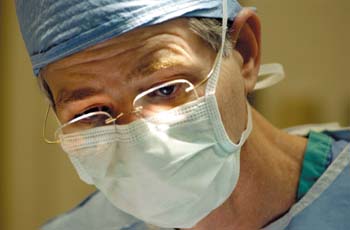
Dr. Dan Beauchamp’s vision is to move the Section of Surgical Sciences into the top 10 in the country. (photo by Dana Johnson)
Quiet intensity — Dan Beauchamp, cancer survivor, honored researcher, grew up with love of science
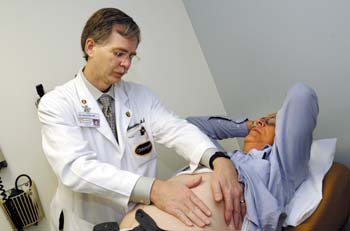
Beauchamp examines William Thompson of Nashville during a regular checkup. Thompson, who praised Beauchamp, underwent colon surgery in 1997. (photo by Dana Johnson)
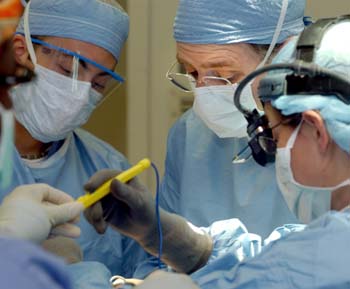
From left, third-year medical student Jeff Jorgenson and Dr. Ingrid Meszoely, chief resident, work with Beauchamp during surgery. (photo by Dana Johnson)
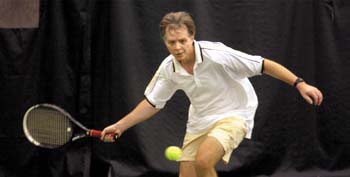
Beauchamp plays tennis every Sunday at The Club at Westside with other Vanderbilt doctors. He balances his personal life with demanding professional duties. (photo by Dana Johnson)
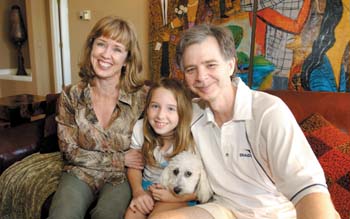
Wife Shannon, daughter Bryn, dog Casper, and Dan enjoy a Sunday afternoon at home. (photo by Dana Johnson)
When Dan Beauchamp was a boy, about 10 years old, he talked so little his mother took him to an audiologist because she thought he was deaf.
“There’s nothing wrong with the boy’s hearing,” the technician said. “His mind’s just a million miles away.”
Far from the small, dry, windy, wildcatter West Texas oil town of Ft. Stockton where he raised a lamb for the county livestock show, Dr. Dan Beauchamp now settles in as chairman of the Section of Surgical Sciences and the John Clinton Foshee Distinguished Professor of Surgery.
Earlier this year, at age 45, he succeeded Dr. James A. O’Neill Jr. on a short, exclusive list of highly prominent Vanderbilt surgeons. After an “exhaustive” national search to fill the chairmanship, the selection committee reached down to Beauchamp and pulled him up from his seat as chief of surgical oncology.
“Dan Beauchamp embodies the best of modern medicine,” Dr. Harry R. Jacobson, vice chancellor for Health Affairs, says of his new section chief. “He is a world-class researcher, a top-notch clinician and a very focused and able administrator. Dan’s continued tireless efforts made him an obvious choice as successor to Jim O’Neill. He not only continues the tradition of Vanderbilt surgical excellence, he’s the one who will continue to improve the Section of Surgical Sciences and move it into the top tier of academic surgical medicine.”
Last year, Beauchamp served as president of the Society of University Surgeons, cementing his name as household among academic surgery. And his international reputation as a researcher already casts a long shadow. But he doesn’t seek the spotlight, and boyishness still surfaces — in a quietness that might be misunderstood as shy, when his head cranes low as he walks, and when a bemused grin spreads across an otherwise calm expression. There’s still some West Texas, too, in a bow-legged gait that carries his tall, slightly stooped frame, in the way words such as “differnt” and “ah-right” genuinely ease into conversation, and in the way he doesn’t make a fuss about much. Why, if he were writing this story about himself, it would probably be over by now.
But when Beauchamp is quiet, it’s because his mind is far away, thinking about what to do, what to say. And when the message finally makes its way out, it’s as clear and succinct as fluorescent bands on a DNA gel.
Vanderbilt’s Section of Surgery now is ranked 35th in National Institutes of Health funding. “I want it to be in the top 15 within five years, and in the top 10 within 10 years,” he says. “Also, I want our medical center to be in the top 10 overall, and I want our resident program included in any discussion of the top five programs in the nation.”
A history of heeling
“Don’t tell him this, but I think I found Dan under a cabbage leaf,” says Georgia Holland, Dan Beauchamp’s mother. Her elder son was born in San Antonio, but when Dan was about seven his family moved to West Texas where his father had taken a job as a ranch manager.
Carl Sandburg once wrote about West Texas, “The only thing between here and the North Star is a barbed wire fence.” But Ft. Stockton, Texas, in the early 1960s was like San Francisco in the 1850s, without the breathtaking Pacific coastal views or valleys green. Rocky buttes, tumbleweeds and jackrabbits shared new company with oil derricks. Wildcatters and roughnecks plugged into oil deposits and pumped money onto the mesa, thick and crude, and it spread around town like sorghum syrup on pancakes.
For Beauchamp, that meant going to a public school in one of the wealthiest counties in the nation, with all the resources to show for it. When America entered the race for space, guided by Texas rocketteers and astronauts, Dan stuck his nose in encyclopedias until it was permanently bent toward science.
His sixth grade teacher picked up on his proclivity. Anne Skylstad says she inherited a whole class of stellar students, Danny Beauchamp among them. “Oh, gosh! What a guy,” she says, still in Ft. Stockton. “He was a good-looking, brainy kid who had every kind of personality aspect that spelled success,” she says, the pride shining with a West Texas glare.
“When the kids were learning astronomy, Danny was in the group that did the planets and stars,” Mrs. Skylstad says. “He started his presentation at 1 o’clock in the afternoon and he was still going when the last bell rung. But he held us, with transparencies and visual aides. He had it all.”
But in the phrenic was balanced by the physical. Ranches there were, and still are, measured in sections—square miles worth 640 acres—and a big one was 10 or more. Like the other kids, Dan rode and roped, worked cattle and sheep, got his hands dirty and got them pinched by fence tools.
But Mrs. Skylstad set Dan down a road that would lead him off the ranch. She was also a registered nurse and had worked in Ft. Worth hospitals and doctors’ offices for 10 years. The school material was below the class’s learning level, so when Dan expressed his interest in science, his teacher gave him her nursing textbooks, and his nose soon picked up a new scent: medicine.
It made his mother happy. “He just pored over the books. That’s when he became focused,” she says. “Danny would steer rope with the other men, headin’ and heelin’. But when he decided to become a doctor he quit. He didn’t want to lose a finger.”
At Vanderbilt the first time
At a scientific meeting in 1986, Dr. Hal Moses, then chairman of Cell Biology, was approached by two men who asked him to dinner—Dr. James Thompson and Dr. Courtney Townsend, a couple of surgeons from the University of Texas Medical Branch at Galveston; Townsend was a professor, Thompson the chair of surgery. The two men painted for Moses a portrait of their fair-haired protégé, Dan Beauchamp, as though they were a couple of monks looking to place an orphan in a good home.
“Once you display Dan to someone, he’s a very easy idea to get across, because he becomes self evident,” says Thompson, now a professor emeritus with powdery tufts of grandfatherly white hair. “You really had to pull things out of Dan. He was a toe-in-the-dirt kind of fella, but an investigator of the first rank. He was able to formulate a question about some clinical or basic research problem and then devise a way of solving that question in a way that was economical and elegant. He’s done that all his life. He is able to identify important questions and plan their solution in such a way as to bring research findings to the patient’s bedside.”
As a surgery resident, Beauchamp became interested in studying pancreatic cancer and read published articles that came out of the Moses lab at Vanderbilt. “They felt my lab was the right place for their prize trainee,” Moses says.
But Beauchamp was the first surgeon to apply for a fellowship. “I had some concerns that he would be someone who would come in and tell everybody what to do and not get his hands dirty,” Moses recalls. “He was the exact opposite.”
Beauchamp spent his school break in Nashville writing a research funding grant with Moses. They were awarded a five-year grant for $325,000; Beauchamp would spend two years here, then return to Galveston for five years to finish other research.
“Two years isn’t very long,” Moses says. “It frequently takes two years to build momentum.”
But Beauchamp was onto something. Out of his two years here, and some follow-up work back in Galveston, he published five studies. His finding — that tumor growth factor is a two-edged sword — is widely considered a minor breakthrough in basic cancer research.
“He’s identified that early in the malignant process TGF beta plays an important growth inhibitory role, but later it may promote tumor progression,” says Dr. Robert J. Coffey, professor of Cell Biology and medicine in Gastroenterology. Coffey says he “grew up scientifically with Dan Beauchamp in Moses’ lab. Back then you could tell that Dan was a remarkable individual. His early finding led to a lot of basic research in many, many labs.”
One out of four RO1 grants proposed to the NIH receive funding, yet Beauchamp also has his name as principal investigator on three competitive RO1 grants, and is a project director on others.
Beauchamp returned to Galveston to finish the five years he promised. But in late 1994, Vanderbilt had a new chief of surgery, O’Neill; Beauchamp was one of the first new surgeons brought to Vanderbilt under his leadership.
“When we recruited Dr. Beauchamp, we saw an individual who had the energy, the clinical expertise and the research creativity that gave us the promise of having a new, sophisticated, cutting edge effort in surgical oncology,” O’Neill says.
With Beauchamp on board, O’Neill says, “because of his vision and efforts, almost overnight we saw surgical oncology expand clinically, and particularly in research.”
The breast cancer center, under Beauchamp, expanded “logarithmically,” O’Neill says, and research in gastrointestinal and pancreatic cancer grew. Also, he says, with Beauchamp, Vanderbilt’s surgery section got a “team builder.” He helped recruit other key faculty, including Dr. Steve Leach, who has since been recruited to Johns Hopkins, Dr. Mark Kelley, assistant professor of Surgical Oncology, and Dr. Scott Pearson, assistant professor of Surgery.
“Dr. Beauchamp played a large role in my coming here,” Pearson says. “He comes across as confident, but reassuring. When I was bridging the gap between training and a staff position, he was a confident leader and someone who could serve as a mentor.”
He’s largely the reason why, O’Neill says, “all of a sudden, Vanderbilt is recognized as the place for surgical oncology.”
But other places wanted Beauchamp to make their places the hot spot. About three years ago, Beauchamp started receiving requests in the mail from medical schools; “come to our school,” they read, “lead our surgery department.”
They went into the trash—at first. Then the big names weighed in. Soon, two major medical schools—Northwestern University Medical School and The University of Texas Southwestern Medical Center — made firm offers. For the first time, Beauchamp seriously considered the leap up the academic ladder. He entertained the offers, visited the campuses; he was now a recruitee. He went quiet about it, thought about it, consulted a giant of American surgery, Dr. Sam Wells. “It’s your responsibility to step up,” he was told.
After more quietness, he decided to remain at Vanderbilt with an established lab and clinical practice, a team he was accustomed to working with and a terrific opportunity.
Teaching patience
It’s Friday afternoon on 9 North, the surgical unit of Vanderbilt University Hospital. A gaggle of residents and medical students in their starched white coats choke the corridor in a circle, much to the chagrin of several nurses trying to make their way to the nurses’ station. They’ve appeared for a lesson; it’s the first time the halls have seen walking rounds in about 25 years, one of them says.
In the center of this human grandstand Beauchamp, the cagey professorial veteran distinct from the crowd because he’s the only one smiling, alternately fires and lobs questions to the white coats.
“This is a medically complicated patient,” Beauchamp announces. “He is on steroids, NSAIDs; he has GERD and just got a cardiac stent. Now he presents with acute abdominal pain. How would you test for peritoneal signs,” he asks. It’s a forehand down the line and, naturally, no one volunteers a return. So, without insolence, like picking out a piece of pie at a diner, he singles out one student. When she whiffs an answer, head down, he floats her a lob with another question. “Suppose you do this….,” he says, and, “is that all you would do, or is there something else?”
The game is not easy, but in the end, everyone wins. That’s his style, says his chief resident, Dr. Ingrid Meszoely. “He’ll ask us, ‘How do you want to proceed?’, instead of telling us how to do it,” Meszoely says. “It’s more like an apprenticeship. You have more freedom to make decisions. He’s a tremendous mentor for people with an interest in surgical oncology,” she says, and adds that Beauchamp has created, perhaps unwittingly, a recent spike in interest in the field among residents—three in her class alone — and medical students.
Beauchamp’s teaching methods bridge clinical knowledge to patient care. When he enters one patient’s room, following the patient’s assigned resident, the patient strains to sit up, his body weak. “Bueno,” says Beauchamp, “como esta?” The Hispanic man is having nutritional difficulties. Maybe because he can’t communicate well with anybody; but Beauchamp has just made a connection. Point made.
Talking to patients is easy, Beauchamp says. Giving them bad news, as he often does, isn’t. One patient, Susan Kuner, pointed that out to him once. She was a doctoral candidate in education and turned her experience with Beauchamp into her dissertation.
“He was the epitome of the scariest, most menacing being I could imagine,” Kuner says. “But that was because of the lens I was looking through.” Her perception was clouded by a diagnosis she received in 1996. She had breast cancer, the disease that killed her grandmother at age 35; her mother had it, too, and received a double mastectomy.
She was referred to Beauchamp, then the chief of surgical oncology, and, despite her family medical history, was determined to prove the diagnosis wrong.
“I challenged his competency. I was terrified,” she says. “I thought he would be defensive, but he very patiently answered every challenge.”
And she kept a journal of her experiences. Afterward, she offered to show them to Beauchamp. “I thought he would be turned off. I never thought he would read them.”
He did. And despite being written about in unflattering terms in their initial meetings, because of that cloudy lens, he understood, Kuner says. “He wrote me back and said, ‘This is something everyone needs to hear. Continue your writing and I will support you.’” The two later made a video about patient-physician communication.
One thing Beauchamp teaches his residents, Meszoely says, is “you gotta figure out when not to operate.”
A discourse about patient care by Beauchamp is more than relating observations. As an MS-2 in Galveston, at the end of a second semester of pathology and at the beginning of his introduction to clinical medicine, Beauchamp was practicing physical examinations on himself when he found a lump in his neck. He had cancer, Hodgkin lymphoma, stage II A.
He called their family doctor and had him explain things to his mother. Then he called her himself.
“I just went all to pieces,” his mother says.
He went through radiation therapy. Townsend, before he was his mentor, was his surgeon. Beauchamp lost weight because food tasted bad.
“It’s not terrible, but it’s not a lot of fun,” he says.
It also was another road sign. Before he had cancer, Beauchamp says, he was sure he was going to be an internist. But surgery offered a different approach to medical problem solving.
Surgical oncology supplies a more immediate gratification, something that attracted Beauchamp: solving acute problems relatively quickly and clearly. But it also affords the opportunity to follow patients long term, sometimes throughout years of care.
Grounded at home
Dr. Bill Nealon, professor of surgery at UTMB Galveston, pulled many long-hour lab shifts with Beauchamp.
“Dan was as likely to suggest that we stay late and process specimens for DNA analysis as he was to suggest or join in on a plan to buy some beer and go try to coax some fish out of the Gulf Coast waters,” Nealon says. “Dan could work, and Dan could play. He combined a remarkable seriousness with a ready wit and mirth.”
Beauchamp still keeps tabs on the first research fellow who worked under him. Tien Ko, assistant professor of Surgery at UTMB Galveston, has seen Beauchamp’s competitive side, the one who picked up a tennis racket two years ago and now plays avidly, taking an occasional swat at the net if it comes into play. And he’s seen the adventurer who delves into ethnic foods on business travels.
“He wants to do everything well, but he doesn’t get bent out of shape when things don’t go his way,” Ko says.
The only thing better than Dan Beauchamp, O’Neill says, is his wife, Shannon Beauchamp. The two met when Dan was in Galveston. Shannon had just finished nursing school and knew Dan as a handsome, athletic, very smart medical student who had cancer. She soon learned how focused he could be, how determined. They were married in 1982 and have a daughter, Bryn, 9.
“Danny is such a hard worker,” Shannon says. “He’s able to juggle so many responsibilities at the same time.”
She says she thought everybody in academic surgery worked as hard as her husband. Dan never made a big deal out of his NIH grants or his discoveries. He did voice one determination: “He said he wanted to be a full professor by 40,” Shannon says. Two weeks before his birthday, O’Neill, then his chairman, phoned him to tell him he was being promoted.
Despite the typical harried schedule of a chairman—working seven days a week, meetings, dinners or receptions at night, travel and sacrifice— Beauchamp finds time to play dad. Every night he’s home, Shannon says, he reads to Bryn at bedtime.
Sometimes, Shannon, who grew up in Idaho, says, “He seems so far removed from where he was.” So far from that West Texas town, from under the oil derricks and off the ranches.
But Shannon Beauchamp, like the rest of his family and his friends who see past the new “chairman” I.D. badge, know Dan Beauchamp as a regular guy, firmly planted at home.
Nealon says, “I can envision Dan starting a presidential speech before one of many societies by which he may be honored by blasting some ZZ Top or a tune from a similar classic band, just to loosen us all up before he shares some of his insights and visions beyond the horizon.”













